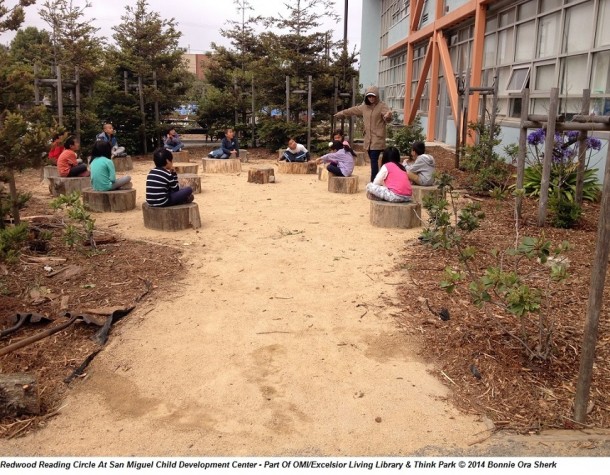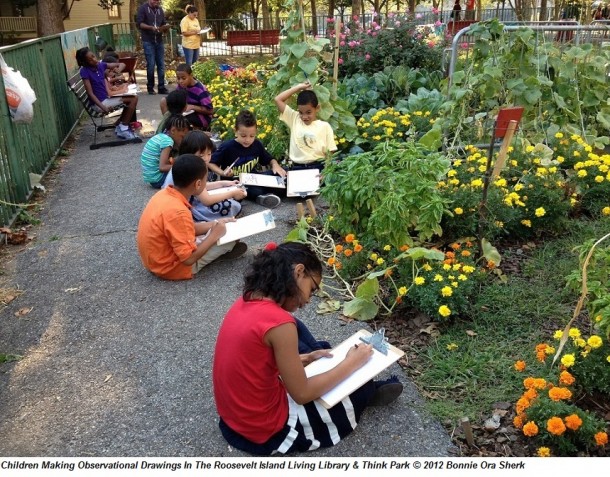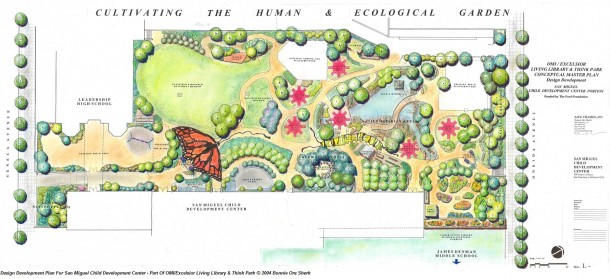U.S.A. Bonnie Ora Sherk, conceptual and performance artist, landscape architect and educator, has been working for more than 40 years in transforming places in ways that capture the natural essence of the environment, while integrating it in the local community and building a strong link between people, art, technology, and the natural world.
Founder and Director of Life Frames Inc. & A Living Library, she has been planning and building place-based, content-rich, ecological and multicultural learning landscapes, demonstrating powerful educational and community integrated systems.
I’ve met Bonnie Ora Sherk at the Ever Gold Gallery in San Francisco, after she completed an interview for the San Francisco Art Quarterly (SFAQ) . A few weeks later we reconnected in New York, Washington Square Park, where we talked about her vision of connecting all in A Living Library, and the power to fulfill such a vision, through what she calls “the quantum stretch of imagination”.
Here, Bonnie Ora Sherk answers some questions about her work, her art, and the absolute performance of Being.
What is A Living Library?
A Living Library is a very powerful framework, and provides a series of strategies and methodologies for making ecological change in communities and schools, that is based on the local resources of each place: human, ecological, economic, historic, technological and aesthetic. When we see those assets through the lens of time: past, present and future – we can learn a lot about a place – and then we can understand how to make relevant, content-rich change and transformation.
A Living Library also suggests a metaphor: Everyone and everything on earth and in space is part of A Living Library of diversity: people, birds, trees, air, water, and all the things that we create, such as parks, gardens, schools, curricula, artworks, networks, communities, celebrations.
A Living Library provides a way to understand that culture and technology are part of nature. It’s all nature! The initials of A Living Library spell A.L.L., and as a structure and learning model, A.L.L. links systems: biological, cultural, and technological.
A Living Library is Cultivating the Human and Ecological Garden, by creating a place with systemically integrated community programs and interdisciplinary hands-on curricula for all ages, that also results in the transformation of the public realm. The development of A Living Library & Think Park, creates a more educated populace as well as an improved, green environment.
How do you build A Living Library, and how much is the community involved in the process?
There are multiple processes to create A Living Library that engages all sectors of the community, from students to government agencies in: research, planning, design, implementation, use, maintenance, management and communications – A.L.L. is an interactive, multi-layered, systemic series of processes, and a learning program for adults and children, linked to the curricula of schools : Pre-K to College – and beyond. All subjects come to life through hands-on, interdisciplinary learning in developing A.L.L.: math, science, history, language arts, multi-arts, technology, health, nutrition, leadership skills, to name a few.
When did you first have this idea?
In March, 1981, when I was spending time in Bryant Park in New York City, I had an epiphany. At that time, Bryant Park, then known as « Needle Park », was rather seedy and forlorn, , but had a formal, elegance, as it embodied a 1934 Beaux Arts design, located adjacent to the Main Research Branch of the New York Public Library, a prominent location in the heart of NYC.
I spent some time in this place and felt its energy. I had this idea to bring the inside of the Library outside, and create Gardens of Knowledge, based on the Dewey Decimal System, a typical American library system for organizing information. This structure fit perfectly into the peripheral gardens of the Park. In each Garden of Knowledge would be plants, visual and performed artworks, and programs that related to each subject, as well as communications technologies, that would bring out more information from the Library, and link to other Branch Living Library & Think Parks in diverse communities – locally and globally. In the Interior of the park would be International Gardens, which would involve the United Nations, Embassies and Consulates in the area. So A.L.L. always offered a global vision as a way to interconnect us, and create opportunities to better understand phenomena, subjects, diverse cultures, and ecologies.
Where do Living Libraries & Think Parks already exist?
There are multiple Branches in San Francisco, in three neighbourhoods, working with seven different schools (PreK-12), where we have year-round programs linked with the schools’ curricula, and work with close to 2000 students per month in hands-on, learning and doing. Two of these neighbourhoods are in the same Watershed. In Bernal Heights, one of the communities in the Watershed, we ‘re also developing A Living Library Nature Walk that is linking multiple schools, parks, public housing, streets, and other open spaces leading to a currently hidden creek, through development of a new, expressive, narrative landscape. This Nature Walk is a prototype for what could be occurring throughout this whole watershed, the largest in San Francisco that interlinks eleven communities. Already we have planted more than 1000 California native trees and hundreds of understory plants, and added interpretive signage. It has really transformed this community, re-attracted wildlife, and is quite beautiful.
In another community, in the heart of Chinatown, San Francisco, a very dense urban environment, we are working with an Elementary School and Child Development Center and are transforming concrete and asphalt into beautiful gardens with integrated rain water harvesting systems.
In New York City, we also have a Branch Living Library & Think Park on Roosevelt Island, where we work with the local school and community. Additionally, each year, in June we have a huge event where adults and children are involved in the annual planting of the RI Living Library & Think Park. On June 21st, we planted this garden, for the twelfth consecutive year.
You recently returned from India where you were invited to present A Living Library in several cities. How was that experience?
I was invited to present A.L.L. in Amedabad, Gujarrat, by the Center for Environment Education, and in Udaipur, Rajisthan by the Big Medicine Charitable Trust. There is a lot of interest now in creating an Udaipur Branch Living Library. It is an ancient city so rich in resources, and yet has a lot of ecological issues that need to be resolved. Creating A Living Library there, will involve the local people directly, and will benefit them and the environment. It will also link their community to different parts of the world and different other communities in India. So this is something that I would like to pursue.
There is interest in Chengdu, China, and in Africa to develop a Branch in Sierra Leone, and Mexico City; also in Turin, Italy, where A Living Library is currently being exhibited in Parco Arte Vivente, and in other parts of the United States, like San Antonio, Texas. I will likely travel this fall to begin the work in both Chengdu and San Antonio.
Revisiting your early work as a conceptual and performance artist, Sitting Still 1 and the Sittlng Still Series are important works that have been displayed and written about all over the world, and still are. Tell us about this.
Sitting Still I was a very powerful piece. I now call this my Watershed Piece.
At the time, I thought I was simply showing how a seated human figure could transform the environment. I was exploring the nature of what, and where, a performance could be, and who could be the audience. I found this area of garbage, where water had collected adjacent to the construction of a freeway interchange. In the middle of all this garbage, floating in the water, was an overstuffed armchair. I saw this, and immediately went home and put on an evening gown, and called my friend to come and photograph me in this environment, in a particular way. I waded into the water, and sat facing the “audience”, the people in the slow-moving cars, because of the freeway construction.
What I did not know at the time, is that I was actually facing my future: what would four years later become Crossroads Community (the farm) – an urban farm and art center that I founded in 1974, and the northernmost frame of the Islais Creek Watershed, that I am still working with today with the Nature Walk, and trying to daylight the Creek where possible. At that time, however, I was actually sitting in water from the Islais Creek that had come forth due to the construction!
After Sitting Still 1, I took the idea of the human seated figure, to different street corners and other urban environments, like the Financial District and the Golden Gate Bridge, to see how that simple action and image could transform a place and situation. I also sat in different indoor / outdoor cages in the San Francisco Zoo. The Sitting Still Series culminated in Public Lunch, in which I had a human meal in a cage, next to the tigers and lions in the adjacent cages at the public feeding time of 2 pm, on a Saturday, in February, 1971, in the Lion House of the San Francisco Zoo.
I thought of my work at that time, as being Environmental Performance Sculpture. At a certain point, I realized that the Ultimate Performance, is to be a Total Human Being. I am still working on the performance of Being.
Would you say that the early work was preparing for A Living Library?
Everything I am doing now has roots in my early work; the seeds were all there. In 1970, with Portable Parks l – lll, I thought, nothing is permanent. Then I realized later, even though nothing is permanent, that some things can endure. That is when I began working on The Farm. That is also the case with developing A Living Library & Think Parks.
A garden is always changing and growing, so you have something temporary in a life frame that endures.
Yes, exactly. Everything is temporary in the larger scheme of things, but, when one looks at the bigger picture of life on this planet, we realize that some things can endure. When you plant a tree, for example, it grows, and when you educate children, it has an impact, and you work with them year after year, after year, and this learning and doing becomes the new normal. So something temporary can also have an enduring impact.
What are the next projects and goals?
My goal is to stabilize the existing Branch Living Library & Think Parks and to start developing new Branches in multiple communities – locally and globally. My biggest dream is to have Branch Living Library & Think Parks in very diverse parts of the world linked through sculptural, Green-Powered Digital Gateways, so that we can share cultures and ecologies, and be simultaneously interlinked, between places – near and far. I think there is an opportunity also to bring it to outer space eventually, once we have developed these Branches on planet Earth. A strategy to reach these goals is to work with Universities in different parts of the world, to develop local Branches in their communities that would involve students from diverse disciplines in development and learning, and simultaneously help the university to give back to the local community.
Since the Earth will be A Living Library…
Exactly, the whole world is A Living Library; we just have to frame it, so we can see it and experience it more profoundly.
The Life Frame helps us to see life more clearly, and experience it better. This has to do with our perception, and our understanding of the richness that is all around us, and we are part of.
The Think Park helps us to think, feel, and be more empathetic.
We need to have a greater sensitivity and appreciation of our planet. There are a lot of environmental issues, as well as cultural issues to overcome, in order to take better care of our planet and each other. We, as human beings, are not the center of the Universe. We are a part of the Universe, and we have to be aware of that in order to take better care of each other, other species, and our planet. We must move from our current pre-adolescent mode, into a more evolved place, as human creatures.
If you are interested in developing A Living Library in your community, or if you want more information on ongoing projects, please visit: http://www.alivinglibrary.org/blog or email: info@alivinglibrary.org





